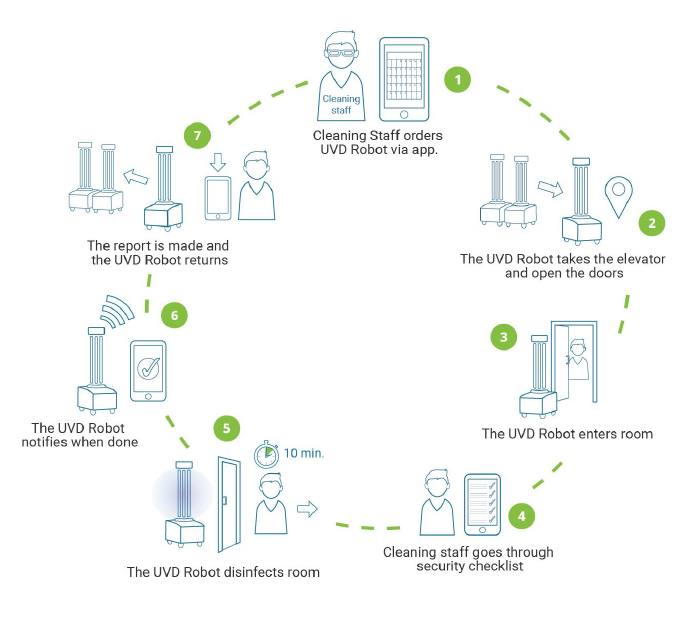Face Recognition Temperature Measurement Terminal Helps you Solve The Queuing Problem
June 20, 2020Temperature Measurement and Disinfection SIFCLEANTEMP-1.4
June 24, 2020Under the new virus outbreak, disinfection and sterilization is the key link to stop the development of the pandemic. However, the medical staff must undertake a lot of disinfection and sterilization work in addition to being busy with the treatment of patients.
In hospitals where patients are replaced frequently, and the frequency of elimination is higher. The work of medical staff would be very heavy.
Hospital Acquired Infections are a significant and increasing problem in the global healthcare sector, where each year millions of patients are infected and thousands of patients die due to infections acquired during hospitalization.
How to effectively reduce the labor intensity of the killing work, so that the majority of medical staff can concentrate on the first-line treatment?
By using ultraviolet rays, the robot can automatically disinfect and kill viruses and bacteria, thereby effectively limiting the spread of coronavirus without putting medical personnel at risk of infection.
At the beginning of the development of the COVID-19, Dr. Anthony Griffiths, associate professor of medical microbiology at Boston University and his team began to develop relevant equipment for this virus research.
In the study, they used UV-C ultraviolet light source products to explore the inactivation ability of different doses of UV-C ultraviolet radiation on the surface of the inoculated material. The research team used a radiation dose of 5 millijoules per square centimeter (mJ/c㎡) (radiation time 6 seconds) and successfully inactivated 99% of the new coronavirus SARS-CoV-2. Based on this data , it is possible to inactivate 99.9999% of the new coronavirus using a radiation dose of 22 millijoules per square centimeter (mJ/c ㎡ ) (radiation time of 25 seconds).
This study along with the need of automation and the relieve of medical staff from disinfection and sterilization labor. The UVC robot has emerged to step in and ensure safety.
The primary factors for choosing disinfection robots are safety, effectiveness and efficiency. At present, the work efficiency, occupational safety, etc. of UVC disinfection robots has been listed in more than 40 countries and regions such as the United States, the United Kingdom, Australia, Japan, and Denmark, and is widely used for air, surface and floor disinfection in other scenes such as hospital fever clinics, ICUs, operating rooms, and office spaces. Its efficacy and sterilization rate have been verified by multiple independent microbiology laboratories in Europe, and have obtained certifications from many countries and regions such as EU CE and German TUV.
The first major feature of the UVC robot SIFROBOT-6.53 is 360 ° no dead angle ultra-high efficiency sterilization, 99.99% sterilization , no residual pollution. The second major feature is ultra-high efficiency and intelligent protection. The 25 ㎡ operating room takes only 10 minutes to complete the disinfection. Within 2 hours, a total of 17 operating rooms in 200 ㎡ can be quickly disinfected. The robot automatically charges for 2.5 hours and can continuously disinfect 9-10 wards.
Moreover, its intelligent safety protection design can automatically stop disinfection when personnel open the door to avoid occupational injuries. As a high-tech product, the robot’s third major feature is its fully automatic operation and remote control. It can automatically locate the disinfection point to ensure effective sterilization at close range within one meter.
These three characteristics of the UVC robot can effectively reduce the frequency of activities of personnel entering the isolation area and the risk of cross-infection, greatly reducing the intensity of the killing work.
A fully autonomous mobile robot emitting concentrated UV-C light onto infectious hotspots in patient rooms and operating rooms, supporting the normal cleaning routines. Prevents and reduces the spread of infectious microorganisms in the environment by breaking down their DNA structure.
Safe, reliable and user friendly as it can be operated by the hospital’s cleaning staff. Reducing hospital acquired infection rates and operating costs. UVC light disinfection technology eliminate any remaining pathogens after manual cleaning processes, such as: Clostridium difficile(C.diff), Staphylococcus aureus (Staphylococcus aureus), Methicillin-resistant Staphylococcus aureus (MRSA), Vancomycin-resistant Enterococcus faecalis (VRE), and Norovirus ( Norovirus)…
The closer the disinfection solution can get to the objects, the greater the intensity becomes. Current disinfection solutions on the market have to be placed manually in the hospital room by the healthcare personnel.
The UV Disinfection Robot is the only disinfection solution capable of locating and positioning itself in the hospital room and getting close enough to all critical objects during the 10 minutes of disinfection process.
The UV-Disinfection Robot will improve and simplify the way we currently disinfect patient rooms. And by letting the robot support the cleaning, we aim to reduce the number of hospital acquired infections, sick leave and-not least-the number of deaths due to infections acquired during hospitalization.
Autonomous mobile solution
Fast and efficient disinfection process
Easy to install and use
Standard process without manual influence

[launchpad_feedback]

1 Comment
Like!! Thank you for publishing this awesome article.